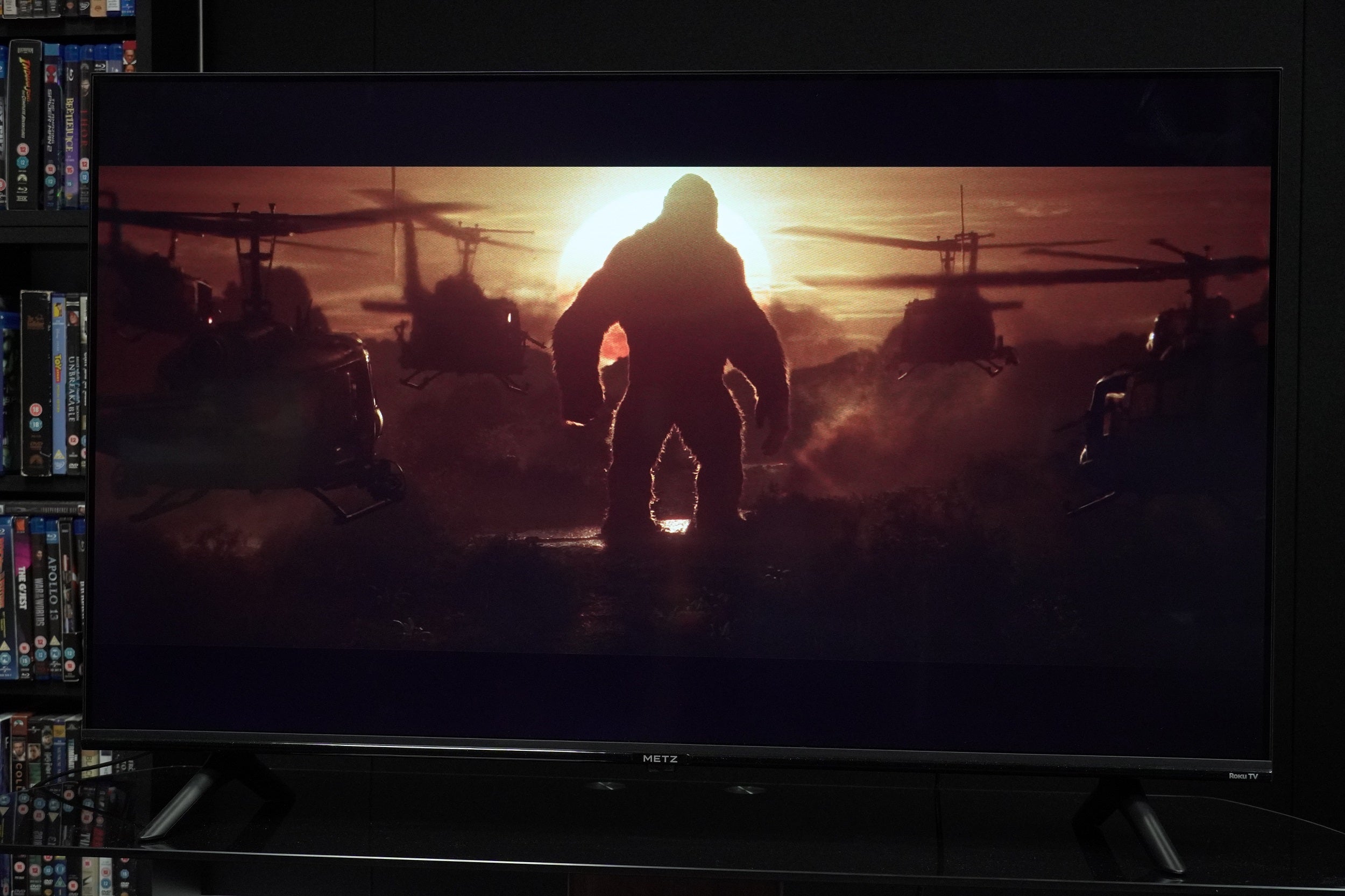Verdict
The price for this Metz Roku TV will get people’s attention, but the picture quality underwhelms with HDR content, lacking brightness, punch, and vibrancy. While the design, interface, and features are all reliably solid, rivals strike a better balance between value and performance.
Pros
- Inexpensive
- Roku TV interface is easy to use
- Good features for the money
- Solid upscaling (with a few tweaks)
Cons
- Lacks brightness for HDR
- Middling audio
- No eARC, Dolby Atmos/Vision
- Very reflective screen in a bright room
-
HDRSupports HDR10 and HLG content -
Roku TVComes with Roku TV integration -
AppsWatch Netflix, Disney+, Prime Video, Apple TV+, iPlayer and more
Introduction
With big-name TV brands paying less attention to the budget TV market, it’s left a wide-open space for the likes of Roku to muscle in, and the Metz MRD6000Z is another model to join the expanding ranks of Roku TVs.
The not so catchily titled MRD6000Z was announced in 2022 but it’s taken time to reach the Trusted Reviews test room. Like the other Roku TVs in the UK, it’s primarily aimed at the type of consumer looking to save money.
Aggressive pricing will attract interest, but the performance at this level can often underwhelm. Here’s hoping the Metz MRD6000Z can punch above its weight class.
Design
- Smart looks
- Easy to assemble
- Reflective screen
The Metz Roku’s level of construction is somewhere between ‘basic’ and ‘smart’, which for a 4K budget TV is a success. It’s anonymous but not an eyesore.
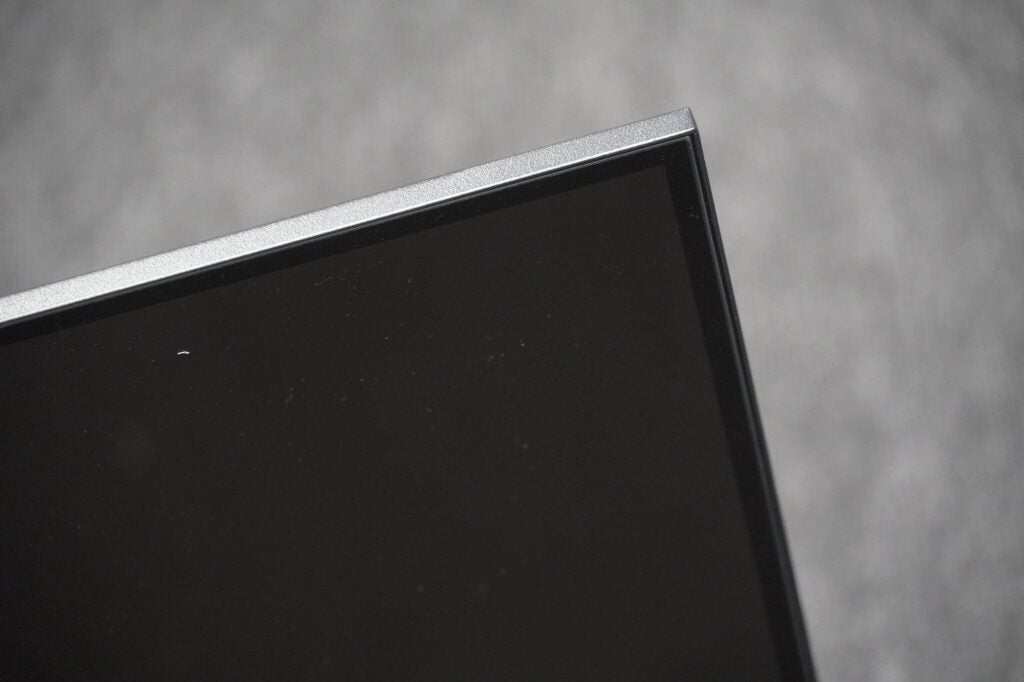
It’s not challenging to assemble either – simply figure out which foot goes on which side, screw it in and it’ll be on your stand in less than three minutes. The feet are placed at either side, but as this is a 43-inch model, it should be fine enough to sit on a small-ish surface.
50-, 55- and 65-inch variants are available – they all look alike – and around the bulky rear are side-facing connections and a detachable power plug.
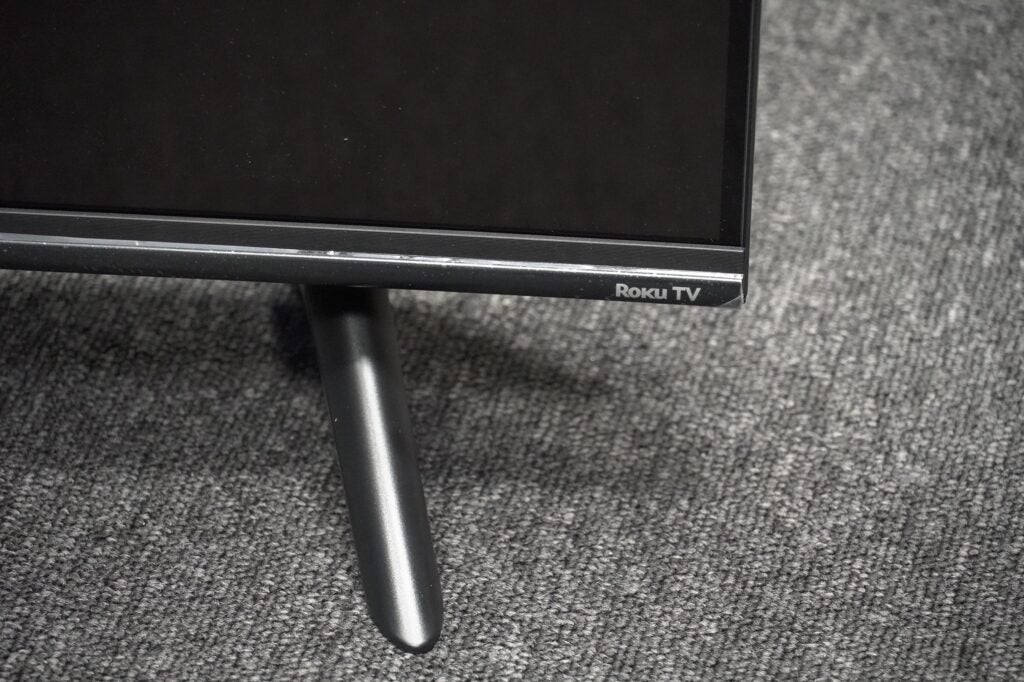

The front-face of this TV is particularly smart – the thin bezels imply the 43MRD6000Z is worth a bit more than its £269 asking price. Viewing angles are below average, though given the screen size, it’s not a TV for the family to crowd around. Still, head-on viewing is the way to go.
It’s not keen on reflections either, not helped by the screen’s lack of brightness. Positioning it away from direct light would be my advice.
Like other Roku TVs my main frustration is directed to the remote. It looks cheap, feels cheap and I’m not in love with the button feedback. It feels lousy to use and it bugs me there isn’t a button for source inputs either.
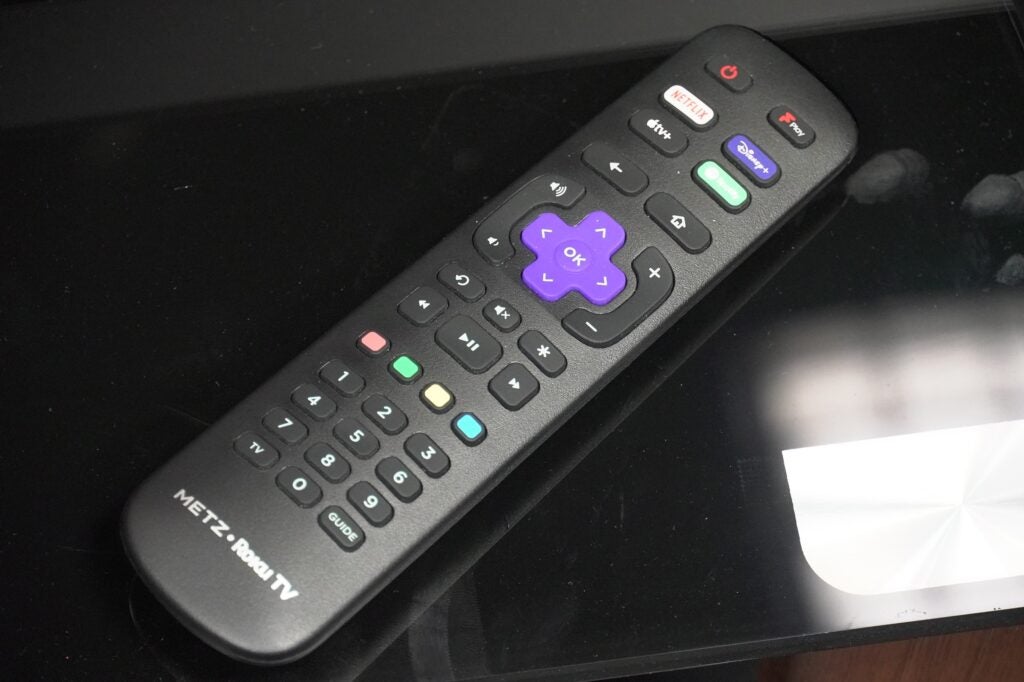

Metz Roku TV interface
- Swift response
- Straightforward to navigate
- Mobile app support
The remote isn’t great, but the Roku TV interface remains intuitive and accessible. I’ve written before that it’s not the most visually arresting UI out there, but it’s simple enough and gets the job done.
The main difference between this and other Roku TV interfaces is the blue background. Otherwise, it follows the same format, separated into Home, Save List, Freeview Play, Search, Streaming Store, and Settings.
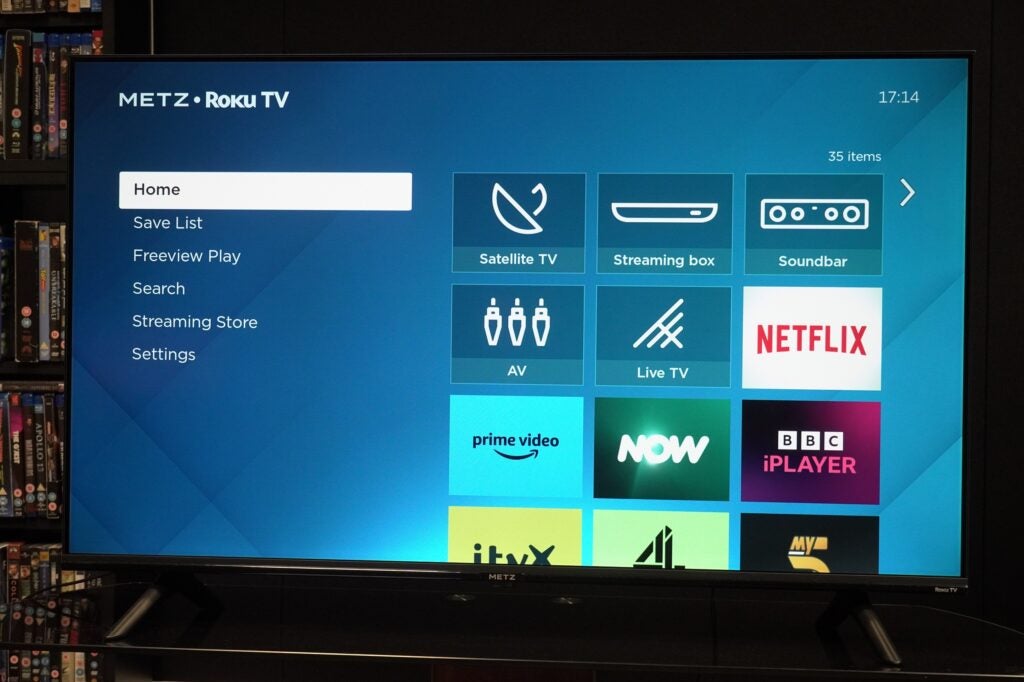

The home screen can be customised, either by editing the name of inputs or moving apps around for quicker access. There’s not a major streaming service I can think of that’s not covered – all the main UK catch-up and on-demand apps, as well as Netflix, Disney+, Apple TV+, to Amazon Prime Video, Sky Store, Spotify and Tidal, are all here. At the time of review BT Sport hadn’t completed its metamorphosis into TNT Sports.
Search for content and the Roku OS scans all apps, though services you subscribe to will feature most prominently.
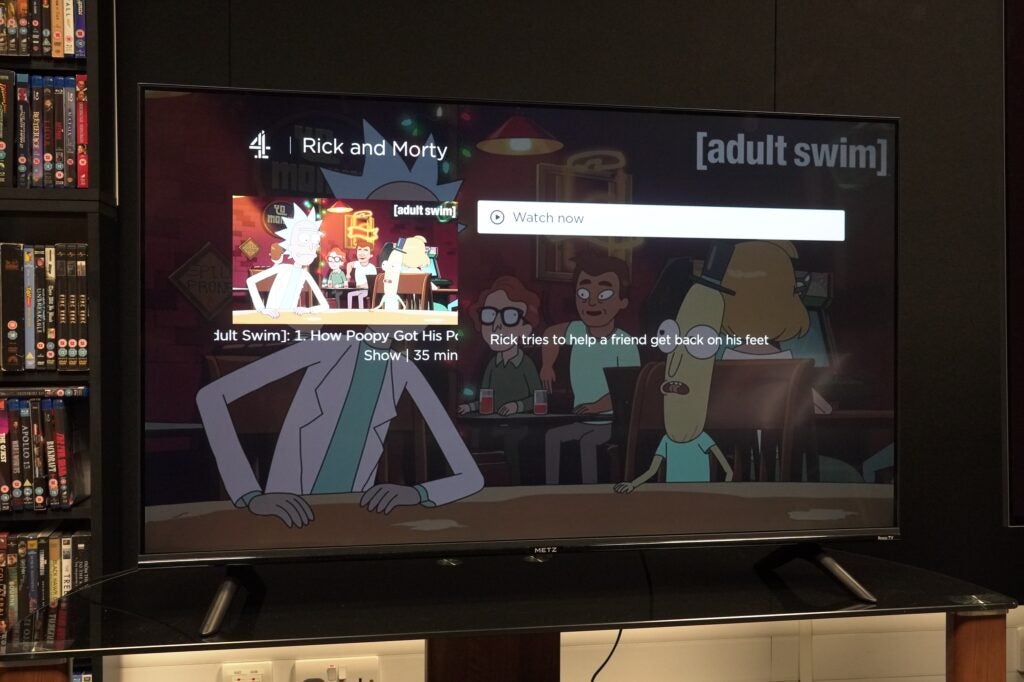

If you find TV interfaces confounding, then Roku’s menus are likely a godsend, though my preference is the mobile app. It’s faster, offers better curation, private listening through headphones, and if you have other Roku devices around the home, they can be managed from the app.
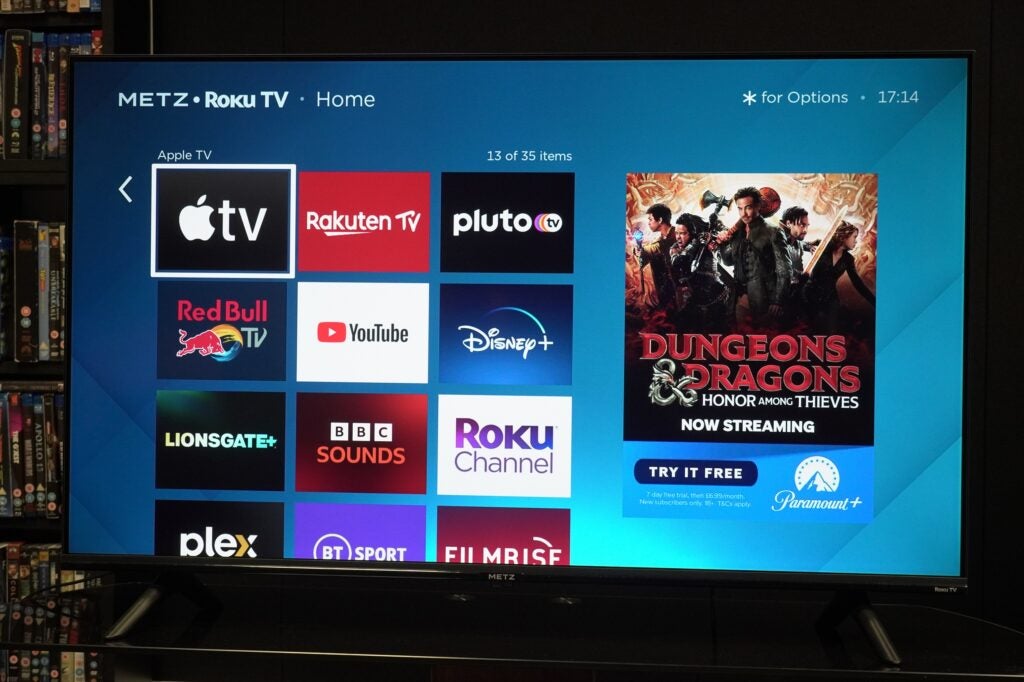

The menu for picture, sound, and other bits and bobs is simple, perhaps to its detriment as customisation mostly concerns turning settings on or off. Advanced settings involve altering RGB levels, though I doubt the majority who buy this TV will consider a trip to those menus.
One tip is to activate ‘One-Touch Play’ if you have sources like a set-top box or 4K Blu-ray. Once the TV senses the device is on, it’ll instantly switch to it.
Features
- Three HDMI inputs
- AirPlay 2 streaming
- Game mode support
The Metz Roku’s feature set covers voice assistance via Amazon, Apple, and Google, though this is available through speakers/devices connected to the TV. If you’re on the iOS platform, you get AirPlay 2 and HomeKit to stream audio or control smart home devices respectively.
There are three HDMI inputs across all screen sizes. One of them is the ARC input for connecting soundbars and sound systems to.
The rest of the connections include two USB inputs, Ethernet, CI+ Slot, digital optical out for audio, and RF antennae for terrestrial TV. You get Wi-Fi but Bluetooth isn’t supported.
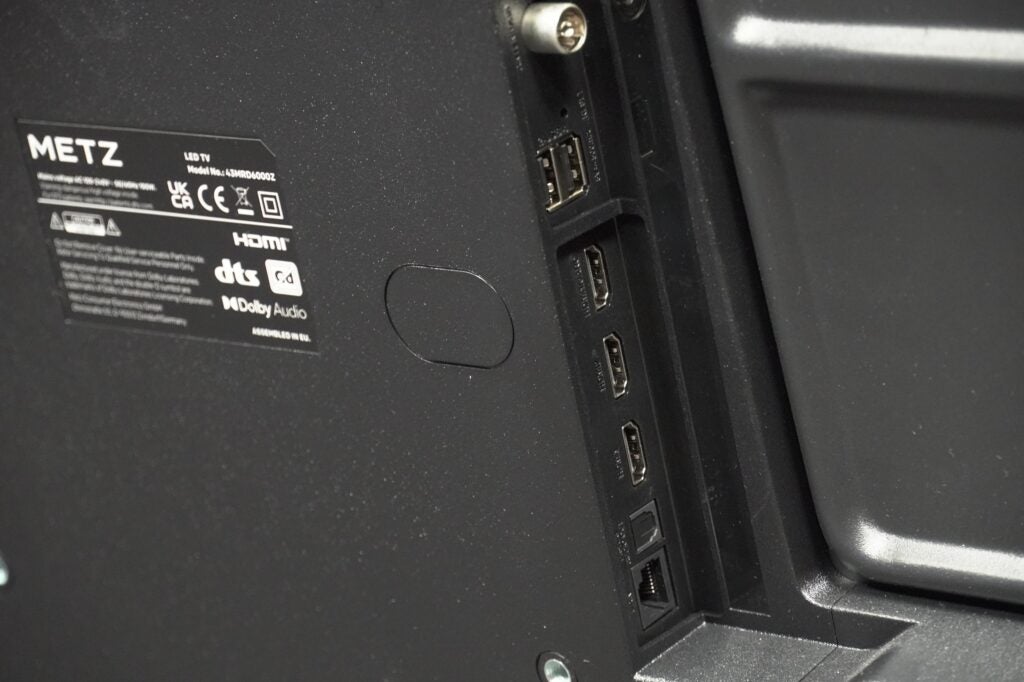

Latency for gaming is 11.8ms when I put the TV into its gaming mode – slightly slower than the TCL Roku and the same as the Sharp Roku model. Regardless, that’s quick enough for any casual gamer to use this as cheaper bedroom gaming screen.
HDR support tallies to HDR10 and HLG, and for audio there’s a 16W audio system that can play Dolby Digital+, Dolby Digital and DTS tracks. There’s no Dolby Atmos (or eARC), cementing this as a TV for those in need of a simple experience and don’t need all the bells and whistles out there.
Picture Quality
- Lacks brightness for HDR
- Over-egged processing on default settings
- Solid upscaling
Brightness is an ever-present an issue for HDR TVs, and it’s particularly felt with the Metz 43MRD6000Z. My tests revealed 279 nits or brightness in Standard mode on a 10% HDR patch, 284 nits in Bright mode and 224 in Dark (or Cinema) mode – and this is with brightness pushed to its highest level. Without that, it’s around 229 nits.
What do all those numbers mean? That the Metz Roku strains to bring brightness and the wide range of colours needed for HDR, which lacks contrast, looks flat and is too dim to have the desired impact.
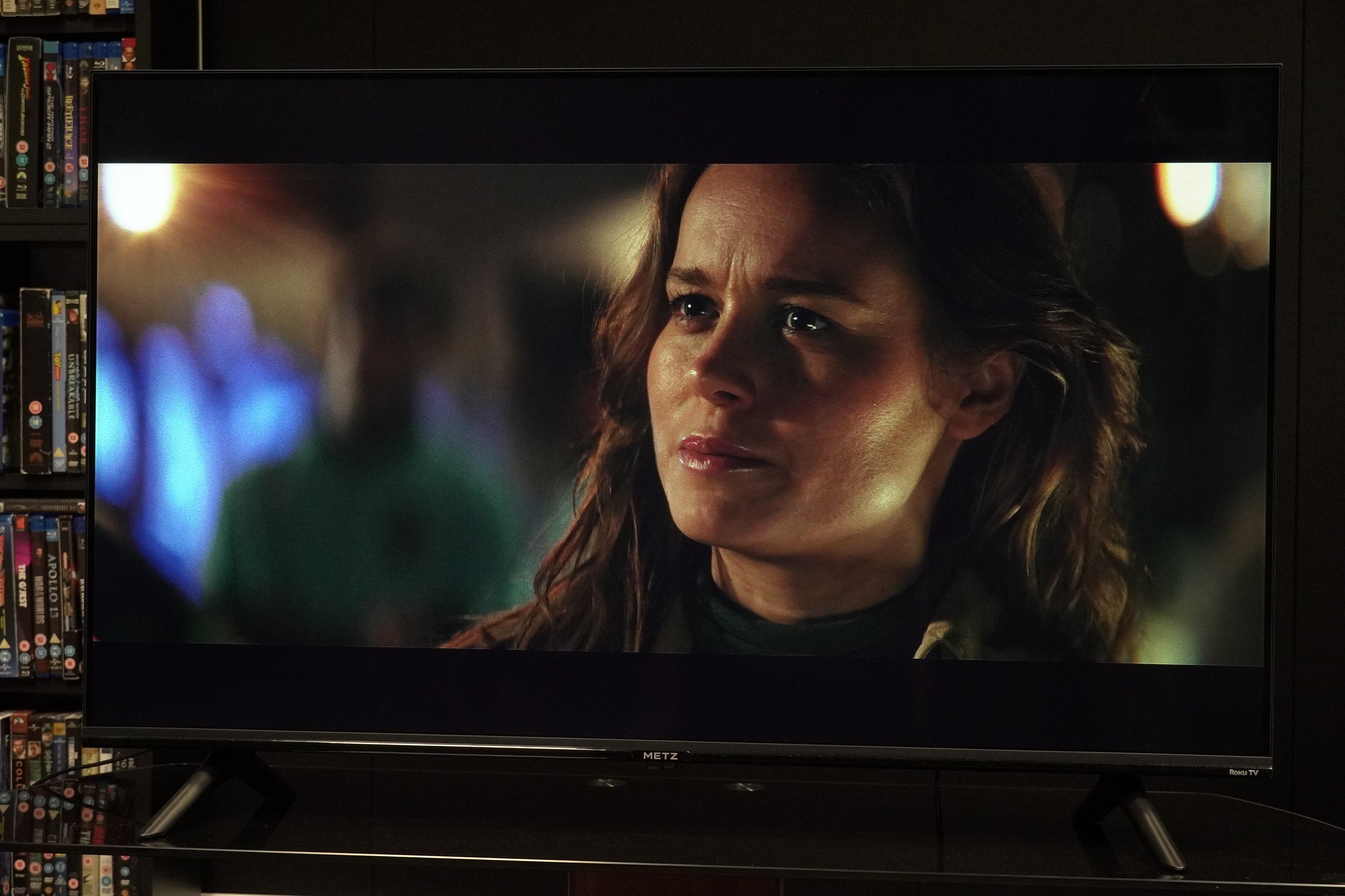
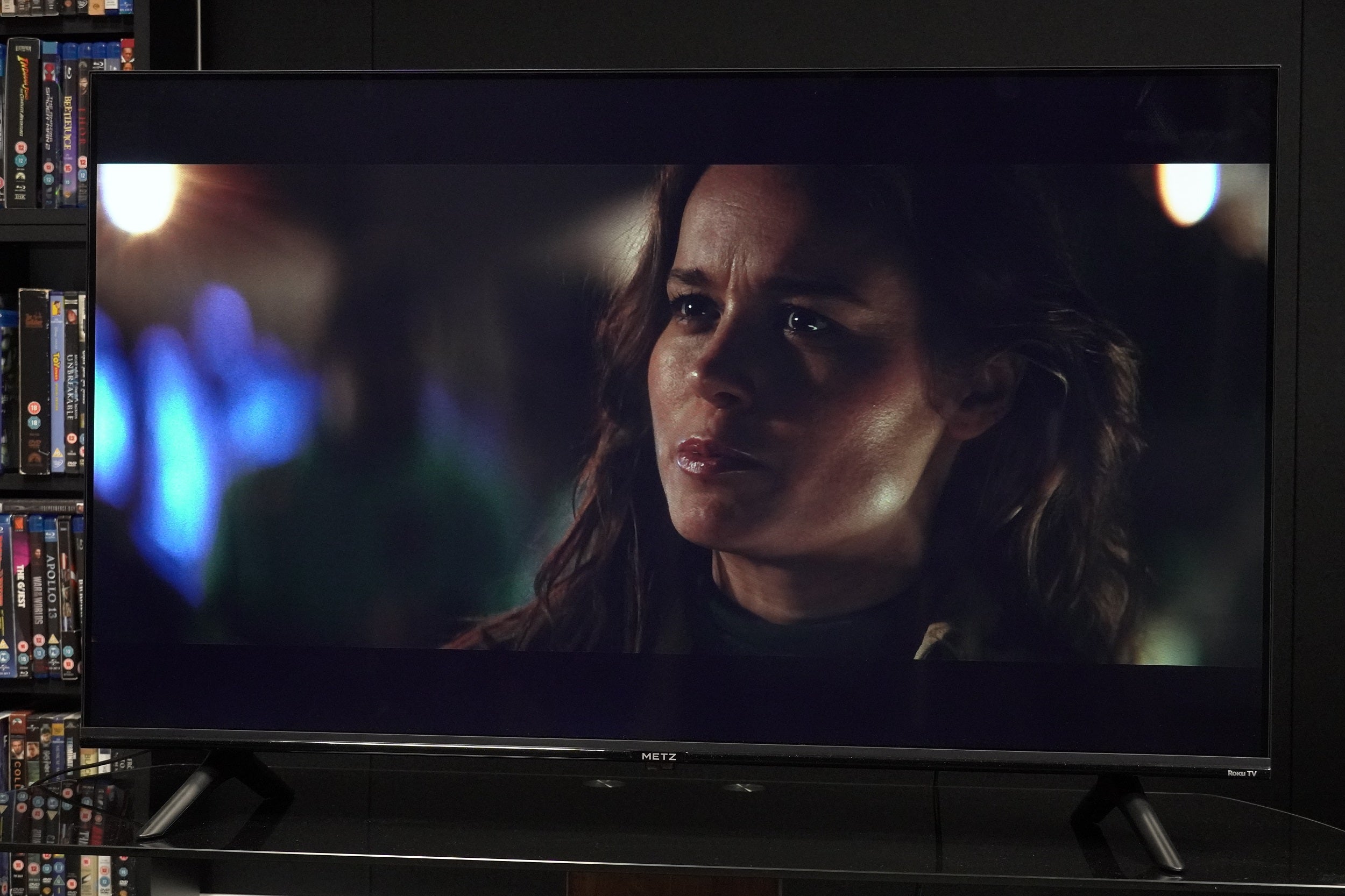
Take Kong: Skull Island, with the 4K version compared to the HD Blu-ray. The 4K Blu-ray lacks detail in the darkest parts of the image so you’re not seeing all the information that’s there. Though colours hit brighter peaks, they lack vibrancy and contrast is lacklustre. The Direct LED panel struggles with backlight bleed as well as a blue tint to black levels.
It’s not as if bright scenes are a marked improvement either. Watching Ahsoka in Dark mode, and while the series is not the brightest or most colourful through its eight-episode run, day scenes look consistently dreary, overcast and flat in terms of contrast. It’s missing most of the attributes that bring out a satisfactory HDR performance.
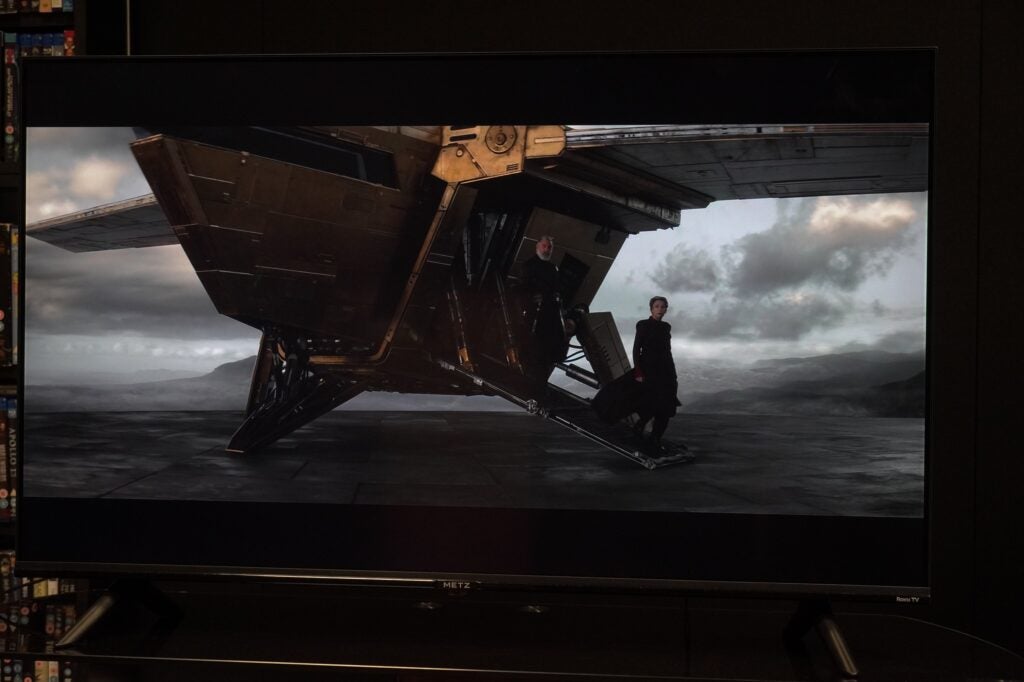

A third (and final) example is Industry on iPlayer in HLG HDR. Dark mode is the most accurate, but it can be difficult to see what’s happening in darker scenes. Upping the brightness pushes actors’ complexions to red, while enabling the Standard mode brings a cooler blue tint that overpowers the colour performance (which is still dark).
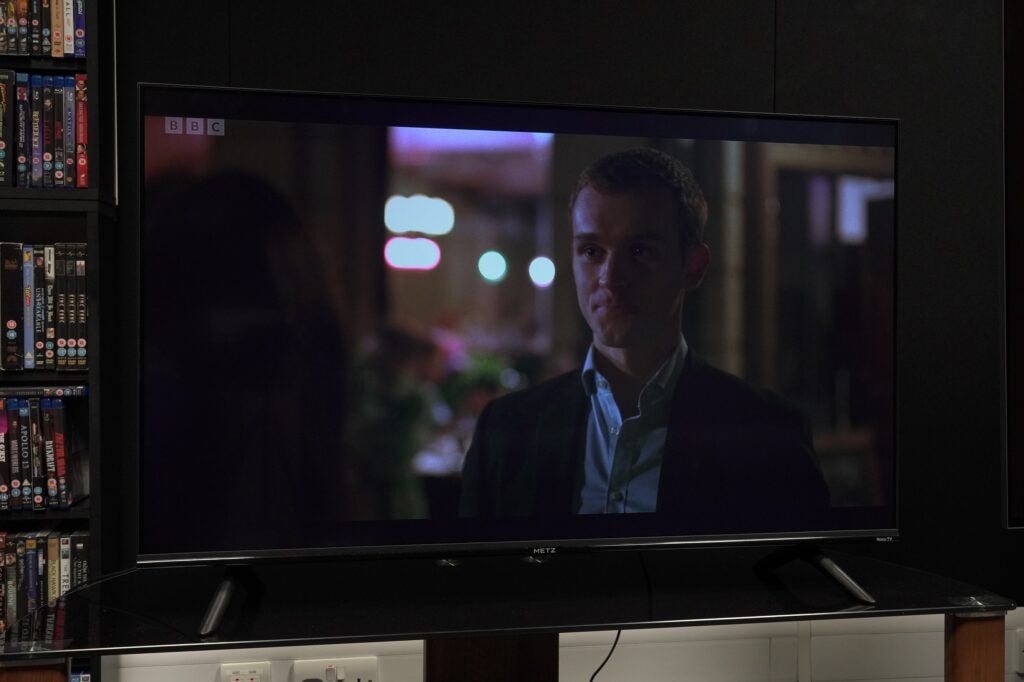

Daytime scenes look better, and TV yields solid levels of detail, sharpness, and clarity across all HDR content, but colours lack punch and expression. You could watch content in SDR and feel more impact, in fact it’s with SDR content that the Metz Roku finds itself on more solid ground.
A Blu-ray of The Martian reveals good sharpness and detail of the science equipment in and out of the Mars’ hub, while the upscaling brings out the intricate detailing and textures of the hero’s spacesuit.
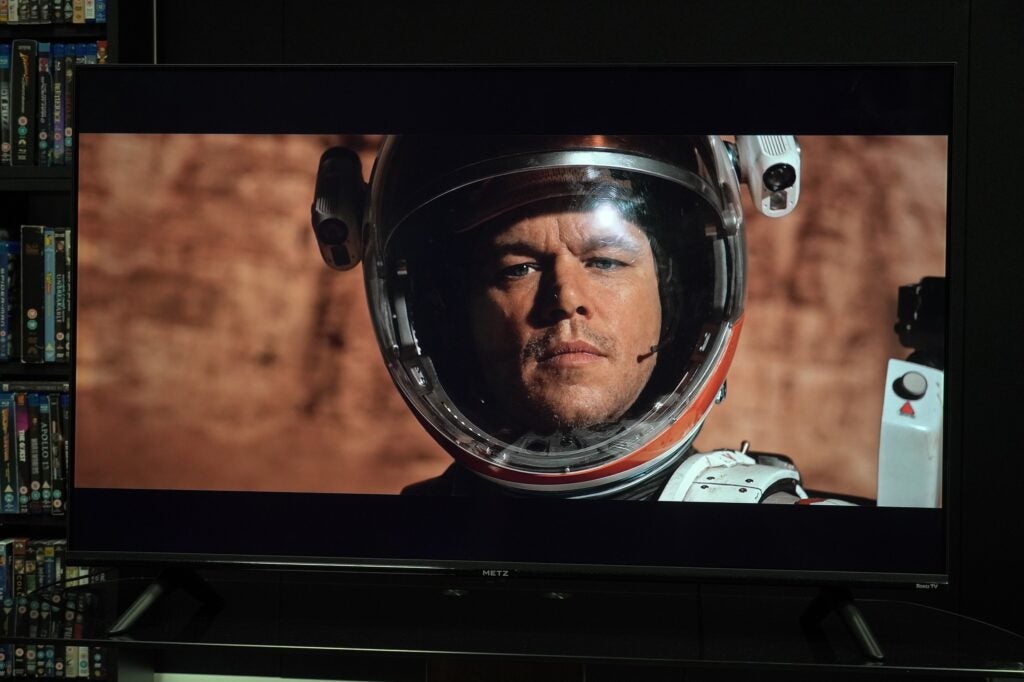

Contrast is better expressed, black levels appear stronger and any struggles with brightness seem far away, though I found there’s too much processing with the TV’s default settings. Matt Damon’s face appears noisy and waxy in close-ups, and it’s the Micro Contrast setting that over-sharpens the image. Turn that off (as well as Dynamic Contrast) and it’s a more natural, better-looking image.
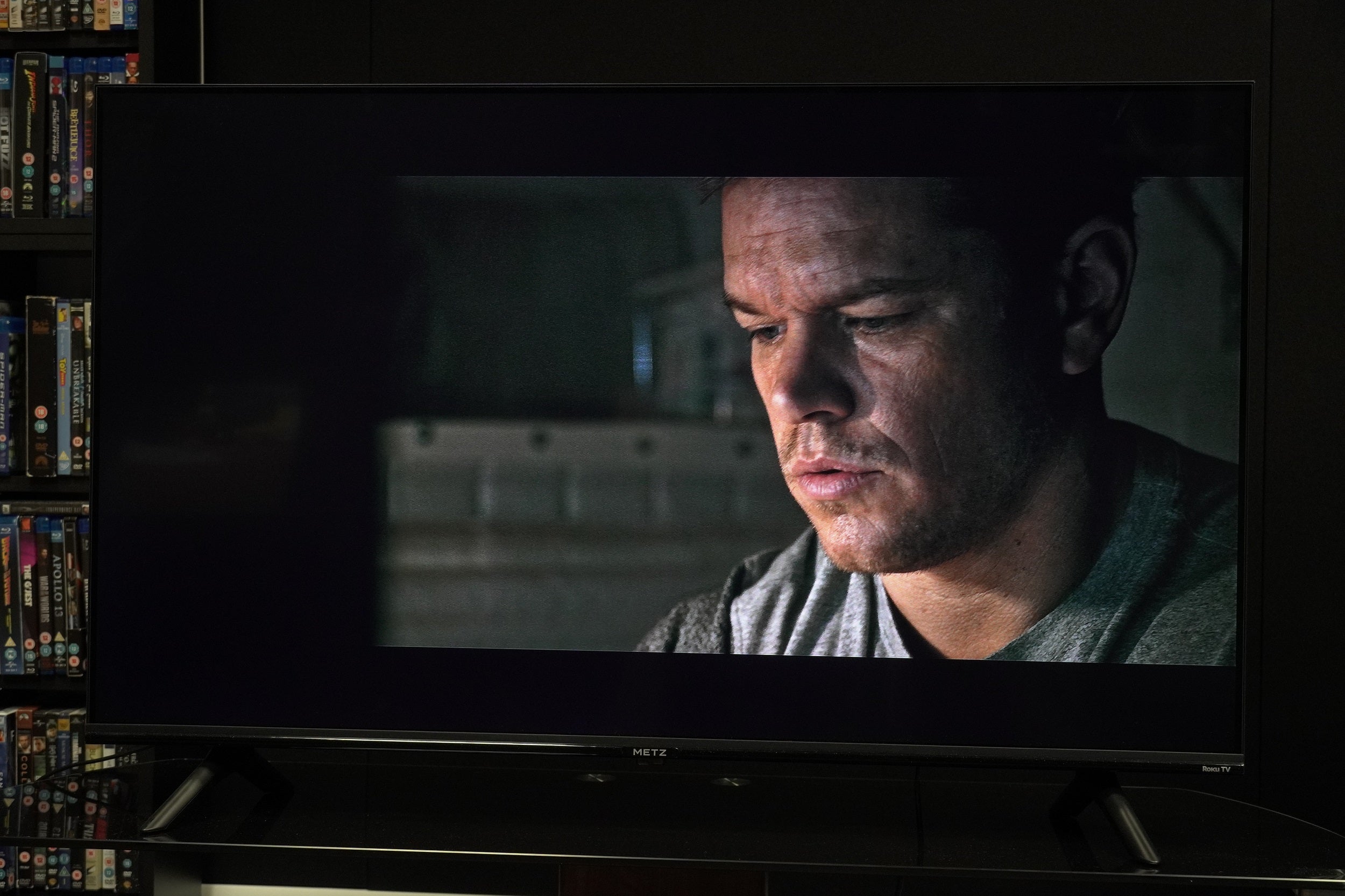
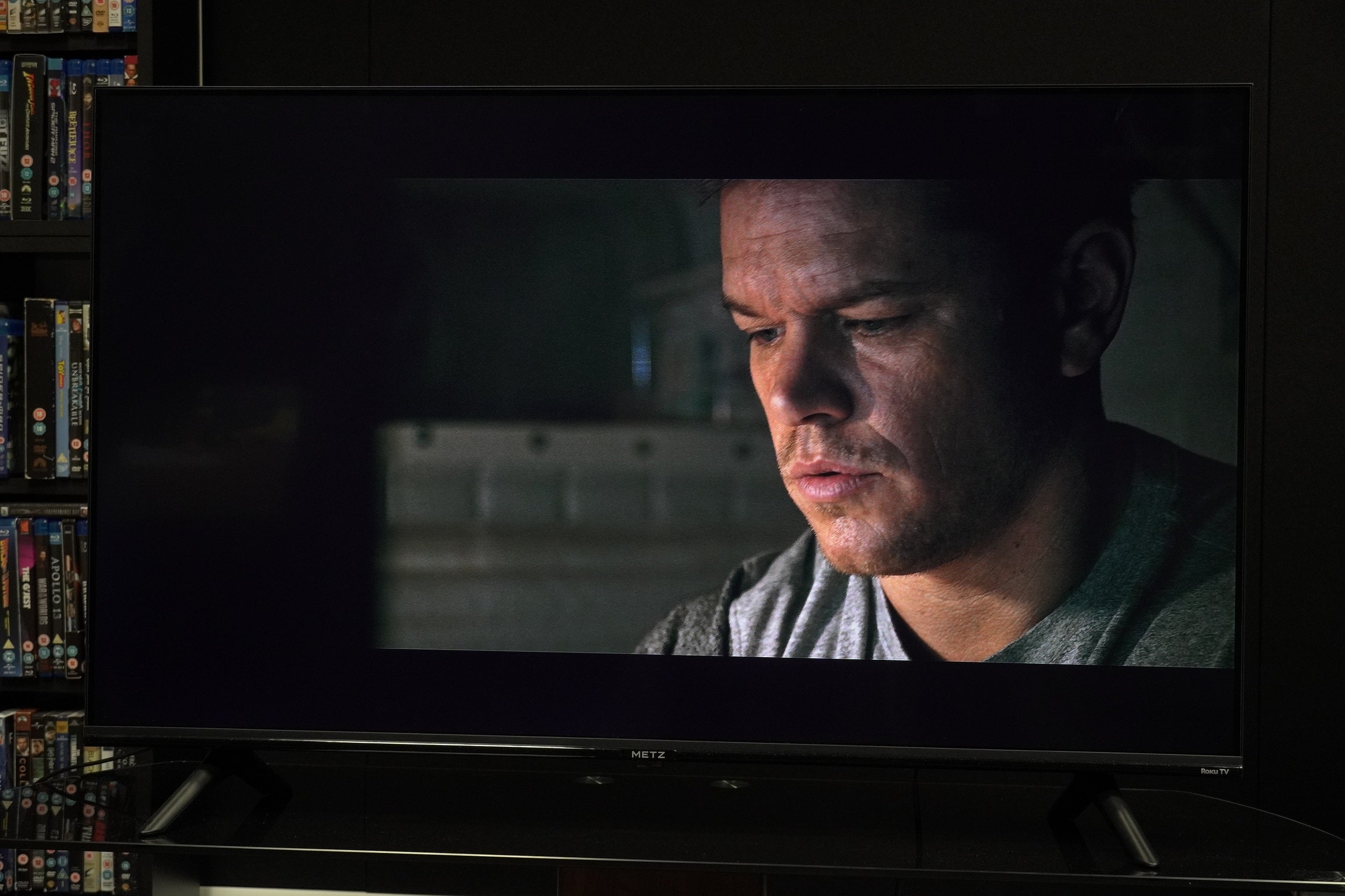
Stepping down to SD content with a DVD of The Matrix Revolutions, and the 43-inch screen can obscure some artefacts but the reduction in sharpness and detail can’t be avoided. With that said, I find it a good-looking image.
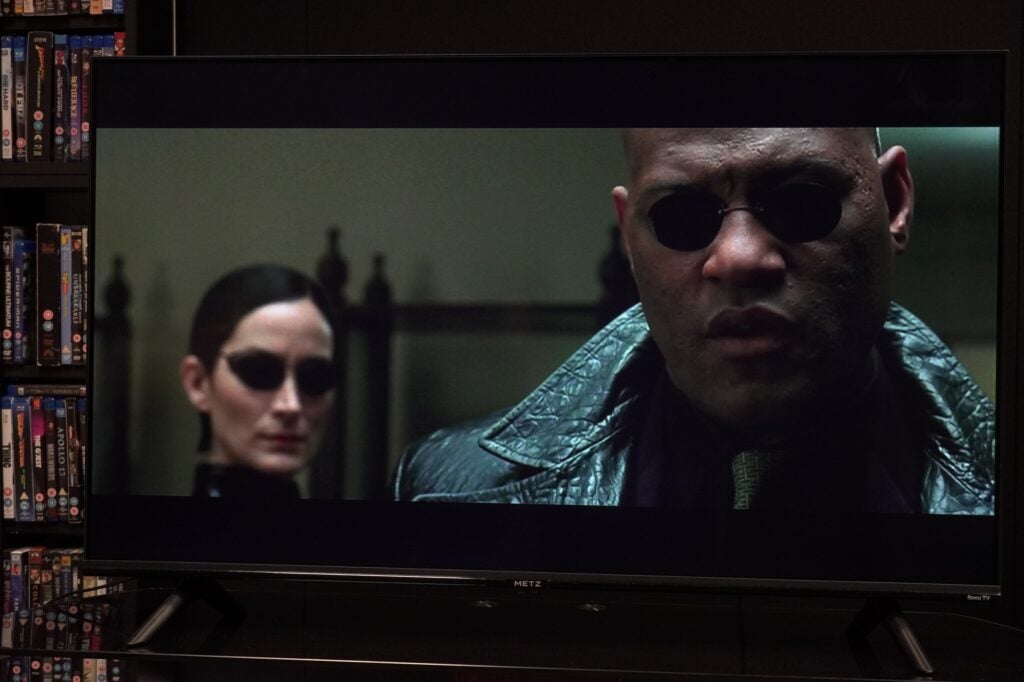

The reproduction of colours is pleasing, black levels have depth and solidity. Definition of edges are smooth enough to not distract, though there is some noise I noticed. I wouldn’t turn off the Noise Reduction for SD content however as it can introduce more noise.
Sound Quality
- Middling bass output
- Good dialogue performance
The Metz 43MRD6000Z has several modes to shape its audio performance. Theatre mode adds depth (or tries to) and widens the soundstage but it can sound murky, especially with background details.
Watching Ahsoka on Disney Plus, the balance between dialogue, music, and effects is not the best, often leading to the music and effects becoming a background player that I can hardly hear.
Standard (or Auto) is clearer and retrieves more detail – dialogue sounds sharper and clearer although thinner in this mode. Theatre lends a smoother tone and more weight, but I don’t think it’s worth the trade-off.
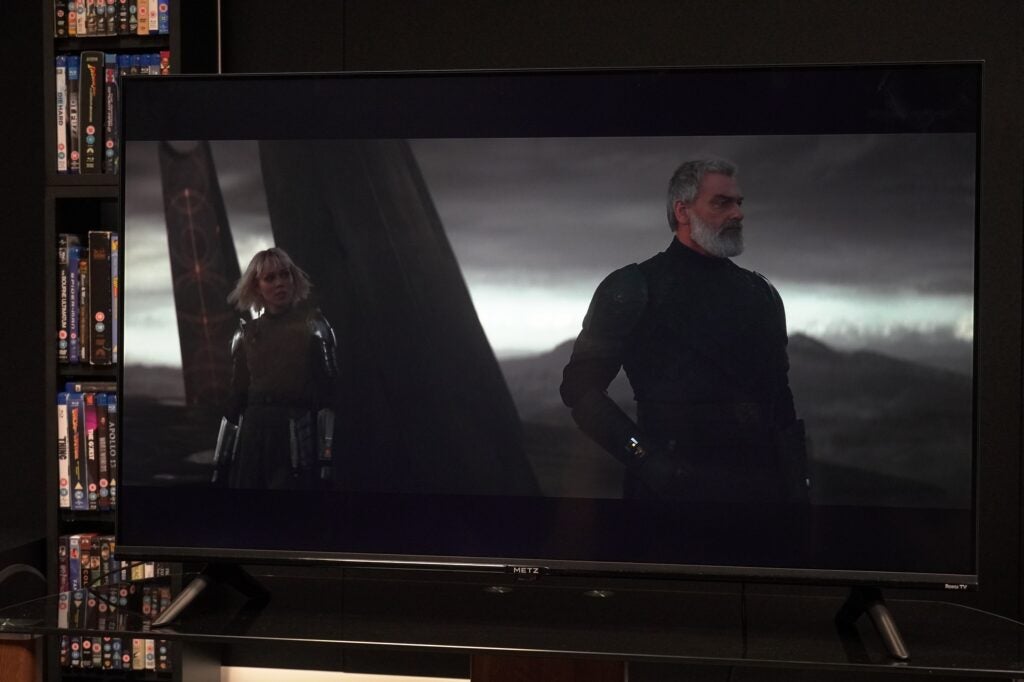

There is a Dialogue Enhancer that gives conversations a boost, although dialogue remains fine without it too. Bass is the most limited aspect of the Metz Roku’s performance. Truncated, muffled, and inarticulate; there’s no weight, punch or excitement to the low frequencies.
The audio system can reach loud-ish volumes, but beyond volume 50 you won’t notice a difference in loudness, size, or the width of the sound.
You should snap up a soundbar, and here are several budget soundbars that improve upon the Metz Roku’s performance.
Latest deals
Should you buy it?
If you don’t want to spend much
£269 for a 43-inch TV is one of the cheapest options I’ve reviewed, but there’s better performance to be had from other models at a similar price.
You watch a lot of HDR content
If you religiously watch HDR, the Metz Roku’s low brightness screen is more of a hindrance than a help for a good HDR performance
Final Thoughts
Even with the big guns seemingly vacating this sector of the market for pastures more expensive, there’s still plenty of competition. From the Xiaomi F2, Amazon Fire TV, Toshiba UF3D and the various other Roku TV models available, there is an abundance of choice, but the Metz Roku is one of the weaker Roku TVs among that line-up.
The design, interface and features are all what you’d expect from a Roku TV, but the picture quality is hampered by a familiar foe – it’s just not bright or expressive enough.
It misses out on features that other rivals have, such as Dolby Vision HDR, eARC and Dolby Atmos. I don’t think that’s as big a deal if you don’t have, or aren’t interested in, the kit/subscriptions needed to take advantage of it. If you are, the Toshiba UF3D or Sharp 43FJ7K are TVs to circle on your shopping list.
If you’re looking for an affordable small TV, this is a decent 4K pick for the inexpensive outlay, but there are better alternatives in your search for a new TV.
How we test
We test every television we review thoroughly over an extended period of time. We use industry standard tests to compare features properly. We’ll always tell you what we find. We never, ever, accept money to review a product.
Find out more about how we test in our ethics policy.
Tested across several weeks
Tested with real world use
Benchmarked with measurable tests
FAQs
This budget TV from Metz supports neither Dolby Vision HDR for picture, or Atmos for sound.
Trusted Reviews test data
Input lag (ms)
Peak brightness (nits) 5%
Peak brightness (nits) 2%
Peak brightness (nits) 10%
Peak brightness (nits) 100%
›
UK RRP
USA RRP
CA RRP
AUD RRP
Screen Size
Size (Dimensions)
Size (Dimensions without stand)
Weight
ASIN
Operating System
Release Date
Model Number
Resolution
HDR
Types of HDR
Refresh Rate TVs
Ports
Audio (Power output)
Connectivity
Colours
Display Technology
›
